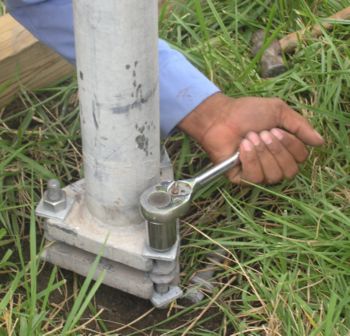903.22 Material Inspection for Sec 903
This article establishes procedures for inspecting and reporting items specified in Sec 903 or in contracts having special provisions for which Materials has inspection responsibility but have not been specifically covered in the specifications.
Contents
903.22.1 Apparatus
- (a) Magnetic gauge, reading range of 0-40 mils (0-1000μm).
- (b) Rule with suitable graduations to accurately measure the material to be inspected.
903.22.2 Procedure
Bridge Division staff will be responsible for the inspection of materials and fabrication associated with Standard Plans 903.10, 903.12 and 903.60, with the exception of the actual signs attached to this material. Any remaining signing materials inspection is the responsibility of the district Construcion and Materials. Unless otherwise specified or arranged, district Construcion and Materials will inspect the galvanizing of all sign materials. High strength bolt assemblies (includes bolt, nut and washer) are subject to the requirements of the PAL program.
Field determination of weight (mass) of coating is to be made on each lot of material furnished. The magnetic gauge is to be operated and calibrated in accordance with ASTM E 376. At least three members of each size and type offered for inspection are to be selected for testing. A single-spot test is to be comprised of at least five readings of the magnetic gauge taken in a small area and those five readings averaged to obtain a single-spot test result. Three such areas should be tested on each of the members being tested. Test each member in the same manner. Average all single-spot test results from all members to obtain the average coating weight (mass) to be reported. The minimum single-spot test result would be the minimum average obtained on any one member. Material may be accepted or rejected for galvanized coating on the basis of magnetic gauge. If a test result fails to comply with the specifications, that lot should be re-sampled at double the original sampling rate. If any of the resample members fail to comply with the specification, that lot is to be rejected. The contractor or supplier is to be given the option of sampling for Laboratory testing, if the magnetic gauge test results are within minus 15 percent of the specified coating weight (mass).
Additional requirements for bolts, nuts and wasters are given in EPG 1080.1.3 Bolts for Highway Lighting, Traffic Signals or Highway Signing.
Polyurethane foam used for footings for embedded type signposts is to be accepted on the basis of manufacturer's certification and random sampling and testing. The manufacturer's certification is to show typical test results representative of the material and certify that the material supplied conforms to all of the requirements specified. Random samples are to be taken from approximately 10 percent of the lots offered for use. A sample is to consist of a portion of each component adequate in size to yield 2 cu. ft. of polyurethane foam, after mixing. AASHTOWare is to be used when submitting samples to the Central Laboratory. Very small quantities of polyurethane foam may be accepted on the basis of brand name and labeling, provided satisfactory results are obtained in the field.
Flexible Delineator Posts
Flexible delineator posts are to be accepted on the basis of manufacturer and brand name approval, manufacturer's certification certifying that the posts and reflective sheeting furnished are of the same composition as originally qualified for manufacturer and brand name approval and in no way has been altered or changed, and field inspection for dimensions and workmanship. Samples are only to be taken when directed by the State Construction and Materials Engineer.
903.22.3 Reports (Records)
Reports shall indicate acceptance, qualified acceptance or rejection. Appropriate remarks, as described in EPG 106.20 Reporting, are to be included in the report to clarify conditions of acceptance or rejection. Distribution of reports for materials purchased under a MoDOT purchase order is to be as described in EPG 1101 Materials Purchased by a Department Purchase Order.
Tests for weight (mass) of coating are to be reported through AASHTOWare. If a sample is submitted to the Central Laboratory for testing, AASHTOWare is to be used. The Central Laboratory will perform the designated tests and complete the report.
All materials inspected by Bridge Division will be issued Fabrication Inspection Shipment Release issued per EPG 1080.2 and reported through AASHTOWare. The manufacturer’s reports for Bridge Division’s inspected items will be retained stored in accordance with EPG 1080.2. All remaining signing materials will be reported by the appropriate inspection personnel.
Polyurethane foam shall be reported through AASHTOWare. The manufacturer's certification shall be retained in the district office, except when reporting very small quantities accepted by brand name and labeling.
Flexible delineator posts shall be reported through AASHTOWare. The manufacturer's certification shall be retained in the district office.
903.22.4 Missouri Supplemental Guide Sign Program
MoDOT inspects materials used under the Missouri Supplemental Guide Sign Program as a “permit” inspection. MoDOT does not directly build the signs, but our specifications and acceptance are required. As a result, an inspector needs to assure that all components are as defined under Sec 903.
903.22.4.1 Procedure
All materials shall comply with the requirements of the MoDOT Standard Specifications and shall be sampled and inspected in accordance with the Engineering Policy Guide.
Time charges for inspection of materials used in the Missouri Supplemental Guide Sign Program shall be as follows:
- Function: 225
- Work ID: UDC 91PE (The UDC number will be the appropriate district or division)
903.22.4.2 Reports
Materials are to be reported using AASHTOWare. Instead of the regular 1042SM material code, the 1042SMLOGO material code should be used.
Reports should be distributed to meet the requirements of a “permit” inspection.
